Vicony Tea Directory


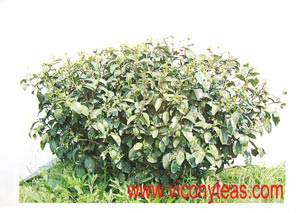 |
|
| Camellia Shrub | Tea Shrub |
Brief Introduction of Camellia Plant
Chinese Camellia sinensis plant is the woody perennial evergreen species of plant whose leaves and leaf buds are used to produce Chinese tea. It is of the genus Camellia, a genus of flowering plants in the family Theaceae. White tea, green tea, oolong, pu-erh tea and black tea are all made from this plant, but are processed in different ways to attain different levels of oxidation. Common names include tea plant, tea tree, and tea shrub.
There are two major varieties that characterize this species (1) Chinese Camellia sinensis var. sinensis (L.) Kuntz and (2) Camellia sinensis var. clonal assamica (Masters) Kitam.
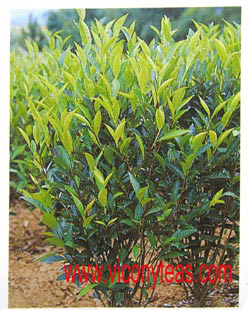 |
|
| Small Camellia Arbor |
Morphology of Camellia Sinensis Plant
There are three varieties of camellia sinensis plant, respectively belonging to shrub, small arbor and arbor. Mostly cultivated camellia sinensis plants belong to shrub with height 1 to 3 meters and without trunks. Most cultivated camellia sinensis in southern China's Fujian and Guangdong provinces belong to small arbor with visible trunks and branches 20 to 30 centimeters above the ground. Camellia sinensis arbor are tall and huge with visible trunks. The wild camellia sinensis found in the virgin forest of Yunnan province of China fell into this category. The camellia sinensis arbor can grow as high as several meters and even more than ten meters. During harvesting time, people need to use ladder or climb on them to pick tealeaves.
The Leaves of camellia sinensis are alternate, simple leaves in shapes of sub-lanceolate, elliptical, oblong, oval, oval and so on, but mostly oval and ovoid. The size of camellia leaf is often used as standards to categorize camellia plant. It is commonly calculated by leaf length × width × 0.7 (factor)of grown leaves. Where more than 60 square centimeters is seen as huge leaf, between 40 ~ 60 cm2 large leaf, between 20 ~ 40 cm2 middle leaf, under20 square centimeters small leaf.
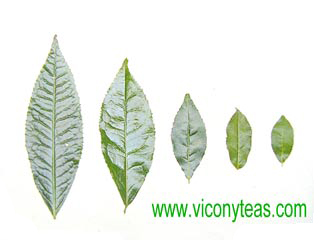 |
|
| The size of camellia leaf is used as standards to categorize camellia plants. | |
There are obvious main vein in fresh camellia leaf and lateral veins of 5 to 15 pairs separating from main veins. The lateral veins which extend in an angle of 60 degree to the edge and then bend upward to link with the lateral vein in front of it, forming a closed network which is an important feature of camellia leaf.
There are three common forms of camellia leaf apex, acute apex, blunt apex and round apex which are also used to categorize chinese camellia plants.
Developed from the bud, camellia leaf consists of scale piece, fish leaf and true leaf. In olivine color, the scale piece grows outside and enwrap young bud to protect it. When young bud growing, the scale piece will soon fall off. Fish leaf is the incomplete true leaf, so named because of its shape with visible main veins and invisible lateral veins. True leaf will come into being when fish leaf grows up. The color and thickness vary by camellia varieties, season, age, growth conditions and cultivation methods. Shoots and young leaves are picked to make tea while mature leaves and old leaves left for photosynthesis to manufacture nutrients and maintain growth.
 |
|
| Different Apex Forms of Camellia Leaves |
The root of camellia sinensis plants is made of taproot, lateral root, radicel and fibril. Taproot can go vertically into soil as deep as 2~3 meters while the root of cultivated camellia shrubs can reach uo to 1 meter. Separating from taproot, lateral root and radicel develop to tranmit water and nutrients so they are both called as transmit roots. Fibril grows on the radicel. It assimilates water and nutrients so called as assimilating roots. Lateral roots, radicel and fibril together constitue root cluster of camellia plants. The size of root cluster generally is 1~1.5 times bigger than that of the camellia tree crown.
 |
| Different Edge Forms of Tea Leaves |
when a camellia sinensis plant matures, branches separate from its trunk and then junior level branches develop from the senior level branches, so on, forming the tussock-shaped crown. The natural grown-up camellia sinensis pant without artificial interference appears to be in tower shape. Cultivated camellia plant commonly has a curved or flat crown due to constant measures such as truncating and disbranching which make it grow breadthwise rather than upward.
Camellia flowers are hermaphrodite, often white, consisting of pedicel, sepals, petals, male core, female core and so on. Camellia buds generally came into being during late June and blossom out in October. It is up to one year and four months from buds blossom to fruits mature.
Camellia fruits belong to the capsules with 1 to 5 chambers, mostly two and three. A camellia seed is composed of husk, seed capsule, cotyledon and embryo. A camellia seed is rich in fat, starch, sugar with a small amount of saponin. Camellia seeds can be extracted to edible oil. Draff can be used to produce wine and aponin.

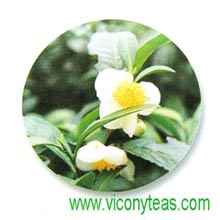 |
| Camellia Flowers | Tea Flowers |
Growing Environment of Camellia Plants
Camellia sinensis plants originated in China's southwest region. It prefers warm, wet and shaded growing environment. It is better to grow in acid soil with annual average temperature between 15 ° C and 25 ° C. Camellia shrubs can generally stand up to -10 ° C temperature and even -15 ° C temperature if it is in short time. The maximum high temperature for camellia sinensis plants is 45 ° C but when it is above 35 ° C, its growth will be inhibited and leaves found to be seared. Areas with annual effective accumulated temperature 3500 ° C can grow camellia sinensis plants. It is suitable to be planted in acid reddish yellow soil with PH value 4.0 ~ 6.5 while the most suitable PH value is 5~6. The soil need to be deep with at least 70 cm thickness and strong water retention. Soil with hard layer or bad drainage capacity isn't suitable for camellia sinensis plant. The basic requirement of rainfall is 1000~2000 mm. Camellia sinensis can be planted in hills and plains preferably mountainous. To avoid being frozen, areas with strong northern winds during winter shouldn't be chosen.
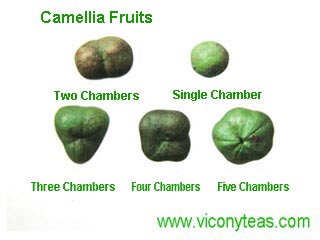 |
| Camellia Fruits | Tea Fruits |
Biological characteristics of Camellia Plant
Chinese Camellia sinensis plant is a perennial crop with life span of several decades even up to several hundreds years. When under good management, camellia sinensis plants can be harvested on a small scale in 3-4 years after planting. In 5 years, it can reach a big annual output and then remain at it for above 30 years.
The lowest daily average temperature of camellia bud growth is 10 °C. The bud growth will accelerate when temperature increases. When daily average temperature falls between 15°C ~20°C, camellia buds grow quickly and tea made of leaves picked at this time is of best quality. When daily average temperature falls between 20°C ~30°C, camellia buds grow vigorously but tea made from the leaves is of inferior quality. When daily average temperature is below 10 °C, camellia buds stop growing and turn into dormancy.
In natural growing environment, camellia sinensis plants in most chinese tea producing areas have three growth periods between which are rest periods.
The first growth period(spring shoots): from late March to early May
The second growth period(summer shoot): from early June to early July
The third growth period(autumn shoots): from middle July to early Oct

When harvested, camellia plants can sprout for five or six times during each year. Shoots develop most vigorously during April and May followed by period from July to September. The conditions required for camellia shoots to develop are different for each growth period. During spring growth period, the most important factor is temperature while in other growth periods, the most deciding factors are nutritional status of the camellia plant when basic temperature condition is met.
The life span of the camellia leaf is 325 days in average by testing different camellia varieties. Generally speaking, camellia leaf developed from spring shoots exists longer than those from summer shoots.
From the third or four years after being planted, a camellia sinensis plant will begin to bloom. From buds come into being to seeds mature, it will be more than 500 days, resulting in an unique phenomenon that camellia flowers and camellia fruits meet together. In chinese most tea producing areas, the differentiation of flower bud begin at late June, anthesis is from September to December. Cross-pollination is fulfilled from middle October to middle November by insects. Camellia fruits mature until the late October of the next year.
The climate in chinese camellia growing areas differs greatly by geographical environment. In tropical region, a camellia plant grows around years. Its growth speed varies only by rainfall. Tea leaves can be harvested almost around years while camellia plants has dormancy in other chinese tea producing areas resulted from low temperature and the amount of rainfall. In chinese Shandong province, the dormancy of camellia plants can reach up to seven months while in most of other chinese producing areas, it is expected to be as long as 4~5 months.
| Green Tea | Black Tea | White Tea | Yellow Tea | Oolong Tea | Dark Tea | Pu Erh | Scented | Flowering | Herbal | Tea Powder |
| Navigation |
| Home (ViconyTeas) |
| Tea Directory (VTD) |
| Tea Importers |
| Tea Exporters |
| Tea Wholesalers |
| Informative Tea Web |
| Tea Association |
| Tea Encyclopedia |
| Online Tea Shop |
| Tea Dictionary Online |
Copyright©2016 | Camellia Sinensis Plant

